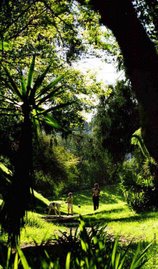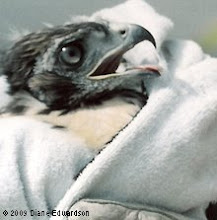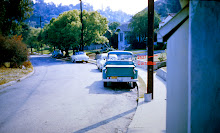Photo: Diane Edwardson, June 18, 2013. I heard the juvenile Red Tailed Hawk calling incessantly & watched as it landed on the slope above the Red Car Property meadow, as if it were attempting to catch a gopher or rat. (Clicking on these photos won't make them much better.)
It stayed on the ground for quite some time calling. The adults spend very little time on the ground (although last year's one chick that was not too bright, even in December and January it was still hunting on the ground). Considering this one just left the nest last week, it seems to be progressing in its skills.
I was able to get quite a few photos before it took off and tried to land on the telephone wire above the slope.
Photo: Diane Edwardson, June 18, 2013. It seemed to want to walk the tightrope. You rarely see adult Red Tails on the wires - they prefer the tops of telephone poles.
Photo: Diane Edwardson, June 18, 2013. The whole time it was walking and flapping it was calling.
Photo: Diane Edwardson, June 18, 2013. Whew. It found its balance, but kept calling.
How do I know it's a juvenile? Beyond the aforementioned behavior, it's kind of scrawny, the chest and shoulder muscles have not filled out yet. And in the photo above, you can see some of the downy chick fluffy feathers peeking out through the adult feathers on its abdomen.
Photo: Diane Edwardson, June 18, 2013. An adult Red Tailed Hawk was constantly nearby keeping a close watch on the juvenile, especially when it flew to the ground and just hung out there on more than one occasion. I also noticed a second adult Red Tail watching from another tree a 100 yards south of these 2 hawks.
IMPORTANT NOTE: I ran into a neighbor's young son, walking his dog on the Red Car Property, who told me he & a friend were able to walk within a few feet of 2 hawks that were on the ground, on the Red Car Property, just the other day. He said he did not try to touch them. (I praised him for that.)
If you find a hawk on the ground, it may not be injured. The youngsters don't make the best decisions. It is best to give them space and observe. If they are truly having trouble flying it will become obvious. Look around, are they in immediate danger from a predator or traffic?
We have rescued hawks on a number of occasions, but only after it was clear they needed human intervention. It is recommended to call a trained raptor rescuer for guidance before you even consider rescuing a possibly injured hawk.
The City's Department of Animal Services has a list of wildlife rescue organizations on their website. We've sent injured Red Tails to the Ojai Raptor Center.
skip to main |
skip to sidebar

Photo: Diane Edwardson

Photo: Edwardson

Photo: Kleven, 1960.
The Corralitas Red Car Property was a private right-of-way through Silver Lake (Los Angeles) for the Pacific Electric interurban streetcar. The “Big Red Cars” ran until 1955 when the Glendale Line was decommissioned for freeway construction. For more than 40 years, a series of developers tried and failed to develop the Corralitas Red Car Property.
It's not a park, it just looks like one.

Photo: Diane Edwardson
Red Car Property Highlights
- Bobcat Sightings
- Legacy of Failed Development
- Red Car Property Development History
- Map
- Silver Lake's Stonehenge
- 2 Freeway History
- 2 Freeway Sound Walls
- 2 Freeway Terminus Project
- Semi-Tropic Spiritualists' Tract
- Public Staircases
- LA River
- Menlo Property
- Metrolink Rail Yard Pollution
- Monte Sano
- Mudwatch
- Neighborhood Native Plants
- Non-Native Plants
- Neighborhood Wildlife
- Red Tailed Hawk Nest Videos
- Ugly Rooftop Watch
- Corralitas Pits of Doom
Historic Neighborhood Photos
- 1904 - 2015 Historic Fletcher Viaduct
- 1904 Curve North of India St.
- 1905 Red Car Property Forest
- 1922 Hunter Terrace - Elysian Gardens Real Estate Brochure
- 1923 - 1962 Holyland Exhibition Collection
- 1923 Allesandro Ave.
- 1927, 1960, 2001 Riverside & Fletcher
- 1930 Lake View Ave.
- 1934 Earl Street Staircase
- 1937 Melton's Market
- 1938-2008 View from atop Corralitas Drive
- 1950 Snow in Silver Lake
- 1953 - 1987 Clarence Inman Collection
- 1960 Corralitas Drive
- 1960 Grass Fire
- 1960 Semi-Tropic Spiritualists' Tract
- 1962 The 2 Freeway Opens
- Paul Landacre Cabin, Historic Landmark

Photo: Edwardson
Neighborhood Wildlife Photos & Highlights
- All Wildlife Posts
- Alligator Lizard
- Birds
- Black Witch Moth
- Bobcat
- Bugs
- Butterflies
- Cooper's Hawk
- Coyotes
- Fox
- Gopher Snake
- Great Blue Heron
- Hawks
- Hummingbirds
- Jerusalem Cricket
- Kestrel
- Moles
- Opossum
- Owls
- Praying Mantis
- Raccoon
- Red Shouldered Hawk
- Reptiles
- Ring-Necked Snake
- Rodents
- Skunks
- Slender Salamanders
- Snake vs Hawk
- Snakes
- Turkey Vulture
- Unusual Bugs
- White-Lined Sphinx Moth

Photo: Kleven, 1960.
Search by Street
Blog Archive
Who we are
- Corralitas Red Car Property
- Community Residents’ Association for Parks is a 501(c)(3) non-profit organization formed in 1997 by our Silver Lake neighborhood. We are dedicated to acquisition and preservation of the Corralitas Red Car Property as a park in partnership with the Santa Monica Mountains Conservancy. Contact: redcarproperty@gmail.com
Links
- Atwater Village Newbie's Red Car Project
- Backwards Beekeepers
- Big Parade LA
- City of Los Angeles 311 Smartphone App
- Electric Railway Historical Association
- LAFD Red Flag Alerts
- Living with Wildlife
- MTA State Route 2 Freeway Terminus Project
- North East Trees
- Northeast LA Residents For Clean Air Coalition
- Pacific Electric Railway Historical Society
- Red Car Trolley Glendale Line
- Semi-Tropic Spiritualists' Tract
- Silver Lake Improvement Association
- Silver Lake Neighborhood Council
- Silver Lake Reservoirs Conservancy
- Silver Lake Residents Association
- The Eastsider LA
- The River Project
- Trust for Public Land
- What's That Bug?
- [sic]
Contact: redcarproperty@gmail.com
Community Residents’ Association for Parks is a 501(c)(3) non-profit organization formed in 1997 by our Silver Lake neighborhood. We are dedicated to acquisition and preservation of the Corralitas Red Car Property as a park in partnership with the Santa Monica Mountains Conservancy.
© 2007 - 2025 Community Residents’ Association for Parks




